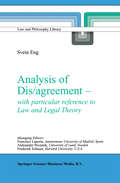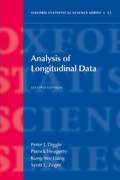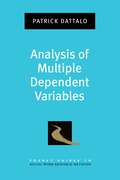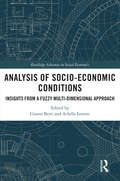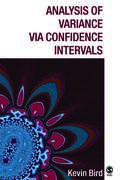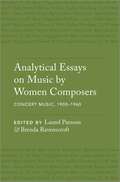- Table View
- List View
An Analysis of Arjun Appadurai's Modernity at Large: Cultural Dimensions of Globalisation (The Macat Library)
by Amy Young EvrardArjun Appadurai’s 1996 collection of essays Modernity At Large: Cultural Dimensions of Globalization helped reshape how anthropologists, geographers and philosophers saw and understood the key topic of our times: globalization. Globalization has long been recognized as one of the crucial factors shaping the modern world – a force that allows goods, people, money, information and culture to flow across borders with relative ease. But if globalization is reshaping the world, it is also viewed with increasing suspicion – and it is still not clear how to understand and conceptualise the huge shifts that are taking place. Appadurai’s work is now considered one of the most influential contributions to the field, largely because of its brilliantly creative approach to the conceptual problems posed by the deep and rapid changes that are involved. Critical thinking lies at the heart of the author’s approach to his writing. A common tactic among gifted creative thinkers is to shift a problem or argument into a novel interpretative framework, and this is exactly what Appadurai did. Modernity at Large interrogates modernity through Appadurai’s notion of ‘scapes,’ a set of separate, interacting flows that, he suggests, cross the globalized world: ethnoscapes (the flow of people), mediascapes (flow of media), technoscapes (technological interactions), financescapes (capital flow), and ideoscapes (the flow of ideologies). By constructing this creative framework, it becomes possible to undertake, as Appadurai does, a brilliant and original investigation of what globalization really means.
An Analysis of Arjun Appadurai's Modernity at Large: Cultural Dimensions of Globalisation (The Macat Library)
by Amy Young EvrardArjun Appadurai’s 1996 collection of essays Modernity At Large: Cultural Dimensions of Globalization helped reshape how anthropologists, geographers and philosophers saw and understood the key topic of our times: globalization. Globalization has long been recognized as one of the crucial factors shaping the modern world – a force that allows goods, people, money, information and culture to flow across borders with relative ease. But if globalization is reshaping the world, it is also viewed with increasing suspicion – and it is still not clear how to understand and conceptualise the huge shifts that are taking place. Appadurai’s work is now considered one of the most influential contributions to the field, largely because of its brilliantly creative approach to the conceptual problems posed by the deep and rapid changes that are involved. Critical thinking lies at the heart of the author’s approach to his writing. A common tactic among gifted creative thinkers is to shift a problem or argument into a novel interpretative framework, and this is exactly what Appadurai did. Modernity at Large interrogates modernity through Appadurai’s notion of ‘scapes,’ a set of separate, interacting flows that, he suggests, cross the globalized world: ethnoscapes (the flow of people), mediascapes (flow of media), technoscapes (technological interactions), financescapes (capital flow), and ideoscapes (the flow of ideologies). By constructing this creative framework, it becomes possible to undertake, as Appadurai does, a brilliant and original investigation of what globalization really means.
The Analysis of Burned Human Remains (Atlas Of Surgical Pathology Ser.)
by Christopher W. Schmidt Steven A. SymesThis unique reference provides a primary source for osteologists and the medical/legal community for the understanding of burned bone remains in forensic or archaeological contexts. It describes in detail the changes in human bone and soft tissues as a body burns at both the chemical and gross levels and provides an overview of the current procedures in burned bone study. Case studies in forensic and archaeological settings aid those interested in the analysis of burned human bodies, from death scene investigators, to biological anthropologists looking at the recent or ancient dead. - Includes the diagnostic patterning of color changes that give insight to the severity of burning, the positioning of the body, and presence (or absence) of soft tissues during the burning event - Chapters on bones and teeth give step-by-step recommendations for how to study and recognize burned hard tissues
The Analysis of Burned Human Remains
by Steven A. Symes Christopher W. SchmidtThe Analysis of Burned Human Remains, Second Edition, provides a primary source for osteologists and the medical/legal community for the understanding of burned bone remains in forensic or archaeological contexts. It describes in detail the changes in human bone and soft tissues as a body burns at both the chemical and gross levels and provides an overview of the current procedures in burned bone study. Case studies in forensic and archaeological settings aid those interested in the analysis of burned human bodies, from death scene investigators to biological anthropologists.A timely state-of-the-art analyses of burned bone studies for bioarchaeologists and forensic anthropologistsCovers the diagnostic patterning of color changes, the positioning of the body, and presence (or absence of soft tissues during the burning eventChapters on bones and teeth give step-by-step recommendations for hot to study and recognize burned hard tissuesNew chapters include improved analyses of thermally induced impacts on bone microstructure, development, and appearance; they also cover sites from a greater geographic range adding Alaska, Italy, Jordan, Mexico, and Southeast Asia
Analysis of Dis/agreement - with particular reference to Law and Legal Theory (Law and Philosophy Library #66)
by S. EngIn order to determine whether two participants in a discussion are in real dis/agreement, one must compare their propositions. Comparison presupposes yardsticks in common. This work thematises such yardsticks, in that it demonstrates the existence, content and factual significance of a relatively well-delimited set of proposition types and proposition patterns, with their accompanying tenability criteria and motivating interests. It is for philosophers, legal theorists, lawyers, and linguists.
Analysis of Dynamic Psychological Systems
by Ralph L. LevineDrawing on sources from a wide range of disciplines, this first volume of a two volume tutorial on systems theory focuses on non-linear dynamical techniques for analysis of feedback processes, information flow, decision making, control theory, and modeling of human behavioral systems.
Analysis of Longitudinal Data (Oxford Statistical Science Ser. #25)
by Peter J. DiggleThe first edition of Analysis for Longitudinal Data has become a classic. Describing the statistical models and methods for the analysis of longitudinal data, it covers both the underlying statistical theory of each method, and its application to a range of examples from the agricultural and biomedical sciences. The main topics discussed are design issues, exploratory methods of analysis, linear models for continuous data, general linear models for discrete data, and models and methods for handling data and missing values. Under each heading, worked examples are presented in parallel with the methodological development, and sufficient detail is given to enable the reader to reproduce the author's results using the data-sets as an appendix. This second edition, published for the first time in paperback, provides a thorough and expanded revision of this important text. It includes two new chapters; the first discusses fully parametric models for discrete repeated measures data, and the second explores statistical models for time-dependent predictors.
Analysis of Multiple Dependent Variables (Pocket Guides to Social Work Research Methods)
by Patrick DattaloThis pocket guide provides a concise, practical, and economical introduction to four procedures for the analysis of multiple dependent variables: multivariate analysis of variance (MANOVA), multivariate analysis of covariance (MANCOVA), multivariate multiple regression (MMR), and structural equation modeling (SEM).
An Analysis of Rachel Carson's Silent Spring (The Macat Library)
by Nikki SpringerRachel Carson’s 1962 Silent Spring is one of the few books that can claim to be epoch-making. Its closely reasoned attack on the use of pesticides in American agriculture helped thrust environmental consciousness to the fore of modern politics and policy, creating the regulatory landscape we know today. The book is also a monument to the power of closely reasoned argument – built from well organised and carefully evidenced points that are not merely persuasive, but designed to be irrefutable. Indeed, it had to be: upon its publication, the chemical industry utilised all its resources to attempt to discredit both Silent Spring and Carson herself – to no avail. The central argument of the book is that the indiscriminate use of pesticides encouraged by post-war advances in agriculture and chemistry was deeply harmful to plants, animals and the whole environment, with devastating effects that went far beyond protecting crops. At the time, the argument directly contradicted government policy and scientific orthodoxy – and many studies that corroborated Carson’s views were deliberately suppressed by hostile business interests. Carson, however, gathered, organised and set out the evidence in Silent Spring in a way that proved her contentions without a doubt. While environmental battles still rage, few now deny the strength and persuasiveness of her reasoning.
An Analysis of Rachel Carson's Silent Spring (The Macat Library)
by Nikki SpringerRachel Carson’s 1962 Silent Spring is one of the few books that can claim to be epoch-making. Its closely reasoned attack on the use of pesticides in American agriculture helped thrust environmental consciousness to the fore of modern politics and policy, creating the regulatory landscape we know today. The book is also a monument to the power of closely reasoned argument – built from well organised and carefully evidenced points that are not merely persuasive, but designed to be irrefutable. Indeed, it had to be: upon its publication, the chemical industry utilised all its resources to attempt to discredit both Silent Spring and Carson herself – to no avail. The central argument of the book is that the indiscriminate use of pesticides encouraged by post-war advances in agriculture and chemistry was deeply harmful to plants, animals and the whole environment, with devastating effects that went far beyond protecting crops. At the time, the argument directly contradicted government policy and scientific orthodoxy – and many studies that corroborated Carson’s views were deliberately suppressed by hostile business interests. Carson, however, gathered, organised and set out the evidence in Silent Spring in a way that proved her contentions without a doubt. While environmental battles still rage, few now deny the strength and persuasiveness of her reasoning.
An Analysis of Richard Dawkins's The Selfish Gene (The Macat Library)
by Nicola DavisRichard Dawkins provides excellent examples of his reasoning and interpretation skills in The Selfish Gene. His 1976 book is not a work of original research, but instead a careful explanation of evolution, combined with an argument for a particular interpretation of several aspects of evolution. Since Dawkins is building on other researchers’ work and writing for a general audience, the central elements of good reasoning are vital to his book: producing a clear argument and presenting a persuasive case; organising an argument and supporting its conclusions. In doing this, Dawkins also employs the crucial skill of interpretation: understanding what evidence means; clarifying terms; questioning definitions; giving clear definitions on which to build arguments. The strength of his reasoning and interpretative skills played a key part in the widespread acceptance of his argument for a gene-centred interpretation of natural selection and evolution – and in its history as a bestselling classic of science writing.
An Analysis of Richard Dawkins's The Selfish Gene (The Macat Library)
by Nicola DavisRichard Dawkins provides excellent examples of his reasoning and interpretation skills in The Selfish Gene. His 1976 book is not a work of original research, but instead a careful explanation of evolution, combined with an argument for a particular interpretation of several aspects of evolution. Since Dawkins is building on other researchers’ work and writing for a general audience, the central elements of good reasoning are vital to his book: producing a clear argument and presenting a persuasive case; organising an argument and supporting its conclusions. In doing this, Dawkins also employs the crucial skill of interpretation: understanding what evidence means; clarifying terms; questioning definitions; giving clear definitions on which to build arguments. The strength of his reasoning and interpretative skills played a key part in the widespread acceptance of his argument for a gene-centred interpretation of natural selection and evolution – and in its history as a bestselling classic of science writing.
Analysis of Socio-Economic Conditions: Insights from a Fuzzy Multi-dimensional Approach (Routledge Advances in Social Economics)
by Gianni Betti Achille LemmiShowcasing fuzzy set theory, this book highlights the enormous potential of fuzzy logic in helping to analyse the complexity of a wide range of socio-economic patterns and behaviour. The contributions to this volume explore the most up-to-date fuzzy-set methods for the measurement of socio-economic phenomena in a multidimensional and/or dynamic perspective. Thus far, fuzzy-set theory has primarily been utilised in the social sciences in the field of poverty measurement. These chapters examine the latest work in this area, while also exploring further applications including social exclusion, the labour market, educational mismatch, sustainability, quality of life and violence against women. The authors demonstrate that real-world situations are often characterised by imprecision, uncertainty and vagueness, which cannot be properly described by the classical set theory which uses a simple true–false binary logic. By contrast, fuzzy-set theory has been shown to be a powerful tool for describing the multidimensionality and complexity of social phenomena. This book will be of significant interest to economists, statisticians and sociologists utilising quantitative methods to explore socio-economic phenomena.
Analysis of Socio-Economic Conditions: Insights from a Fuzzy Multi-dimensional Approach (Routledge Advances in Social Economics)
by Gianni Betti and Achille LemmiShowcasing fuzzy set theory, this book highlights the enormous potential of fuzzy logic in helping to analyse the complexity of a wide range of socio-economic patterns and behaviour. The contributions to this volume explore the most up-to-date fuzzy-set methods for the measurement of socio-economic phenomena in a multidimensional and/or dynamic perspective. Thus far, fuzzy-set theory has primarily been utilised in the social sciences in the field of poverty measurement. These chapters examine the latest work in this area, while also exploring further applications including social exclusion, the labour market, educational mismatch, sustainability, quality of life and violence against women. The authors demonstrate that real-world situations are often characterised by imprecision, uncertainty and vagueness, which cannot be properly described by the classical set theory which uses a simple true–false binary logic. By contrast, fuzzy-set theory has been shown to be a powerful tool for describing the multidimensionality and complexity of social phenomena. This book will be of significant interest to economists, statisticians and sociologists utilising quantitative methods to explore socio-economic phenomena.
Analysis of the Development of Beijing (2018)
by Beijing Academy of Social SciencesThis book provides an overview of the rapid development Beijing has seen in a wide range of areas in 2017, both in itself and as an integral part of a larger region, as China’s economic development continues to improve in overall quality and regional coordination. General reports on progress Beijing made and problems it faced in 2017 in improving its economy, public services, municipal and community governance, urban planning, and funding for innovations are followed by case studies that look at best practices and how they can be applied towards promoting coordinated development of the Beijing-Tianjin-Hebei region. The strategy features prominently in the outlook contributors present for the greater metropolitan area of Beijing for 2018.This book is a valuable source of reference for anyone trying to gain a better understanding the what, how, and why in relation to one of the world’s fastest growing mega-cities.
Analysis of Variance via Confidence Intervals
by Dr K D BirdAnalysis of variance (ANOVA) constitutes the main set of statistical methods used by students and researchers to analyse data from experiments. This expertly written textbook adopts a pioneering approach to ANOVA with an emphasis on confidence intervals rather than tests of significance. Key features of the book include: · Extensive coverage · Strong emphasis upon practical examples · Web-based links to sample questions and answers Student-focused throughout, it offers a comprehensive introduction to ANOVA using confidence intervals. The chapters have been organized to fit onto a typical lecture programme and is well-structured and practical, invaluable for undergraduates and postgraduate students taking courses in quantitative methods across the social sciences.
The Analyst’s Desire: The Ethical Foundation of Clinical Practice (Psychoanalytic Horizons)
by Mitchell WilsonMitchell Wilson explores the fundamental role that lack and desire play in psychoanalytic interpretation by using a comparative method that engages different psychoanalytic traditions: Lacanian, Bionian, Kleinian, Contemporary Freudian. Investigating crucial questions Wilson asks: What is the nature of the psychoanalytic process? How are desire and counter-transference linked? What is the relationship between desire, analytic action, and psychoanalytic ethics?
The Analyst’s Desire: The Ethical Foundation of Clinical Practice (Psychoanalytic Horizons)
by Mitchell WilsonMitchell Wilson explores the fundamental role that lack and desire play in psychoanalytic interpretation by using a comparative method that engages different psychoanalytic traditions: Lacanian, Bionian, Kleinian, Contemporary Freudian. Investigating crucial questions Wilson asks: What is the nature of the psychoanalytic process? How are desire and counter-transference linked? What is the relationship between desire, analytic action, and psychoanalytic ethics?
Analytic Activism: Digital Listening and the New Political Strategy (Oxford Studies in Digital Politics)
by David KarpfAmong the ways that digital media has transformed political activism, the most remarkable is not that new media allows disorganized masses to speak, but that it enables organized activist groups to listen. Beneath the waves of e-petitions, "likes," and hashtags lies a sea of data - a newly quantified form of supporter sentiment - and advocacy organizations can now utilize new tools to measure this data to make decisions and shape campaigns. In this book, David Karpf discusses the power and potential of this new "analytic activism," exploring the organizational and media logics that determine how digital inputs shape the choices that political campaigners make. He provides the first careful analysis of how organizations like Change.org and Upworthy.com influence the types of political narratives that dominate our Facebook newsfeeds and Twitter timelines, and how MoveOn.org and its "netroots" peers use analytics to listen more effectively to their members and supporters. As well, he identifies the boundaries that define the scope of this new style of organized citizen engagement. But also raising a note of caution, Karpf identifies the dangers and limitations in putting too much faith in these new forms of organized listening.
ANALYTIC ACTIVISM OSDP C: Digital Listening and the New Political Strategy (Oxford Studies in Digital Politics)
by David KarpfAmong the ways that digital media has transformed political activism, the most remarkable is not that new media allows disorganized masses to speak, but that it enables organized activist groups to listen. Beneath the waves of e-petitions, "likes," and hashtags lies a sea of data - a newly quantified form of supporter sentiment - and advocacy organizations can now utilize new tools to measure this data to make decisions and shape campaigns. In this book, David Karpf discusses the power and potential of this new "analytic activism," exploring the organizational and media logics that determine how digital inputs shape the choices that political campaigners make. He provides the first careful analysis of how organizations like Change.org and Upworthy.com influence the types of political narratives that dominate our Facebook newsfeeds and Twitter timelines, and how MoveOn.org and its "netroots" peers use analytics to listen more effectively to their members and supporters. As well, he identifies the boundaries that define the scope of this new style of organized citizen engagement. But also raising a note of caution, Karpf identifies the dangers and limitations in putting too much faith in these new forms of organized listening.
Analytic Narratives
by Margaret Levi Barry R. Weingast Robert H. Bates Avner Greif Jean-Laurent RosenthalStudents of comparative politics have long faced a vexing dilemma: how can social scientists draw broad, applicable principles of political order from specific historical examples? In Analytic Narratives, five senior scholars offer a new and ambitious methodological response to this important question. By employing rational-choice and game theory, the authors propose a way of extracting empirically testable, general hypotheses from particular cases. The result is both a methodological manifesto and an applied handbook that political scientists, economic historians, sociologists, and students of political economy will find essential. In their jointly written introduction, the authors frame their approach to the origins and evolution of political institutions. The individual essays that follow demonstrate the concept of the analytic narrative--a rational-choice approach to explain political outcomes--in case studies. Avner Greif traces the institutional foundations of commercial expansion in twelfth-century Genoa. Jean-Laurent Rosenthal analyzes how divergent fiscal policies affected absolutist European governments, while Margaret Levi examines the transformation of nineteenth-century conscription laws in France, the United States, and Prussia. Robert Bates explores the emergence of a regulatory organization in the international coffee market. Finally, Barry Weingast studies the institutional foundations of democracy in the antebellum United States and its breakdown in the Civil War. In the process, these studies highlight the economic role of political organizations, the rise and deterioration of political communities, and the role of coercion, especially warfare, in political life. The results are both empirically relevant and theoretically sophisticated. Analytic Narratives is an innovative and provocative work that bridges the gap between the game-theoretic and empirically driven approaches in political economy. Political historians will find the use of rational-choice models novel; theorists will discover arguments more robust and nuanced than those derived from abstract models. The book improves on earlier studies by advocating--and applying--a cross-disciplinary approach to explain strategic decision making in history.
Analytic Narratives (PDF)
by Robert H. Bates Avner Greif Margaret Levi Jean-Laurent Rosenthal Barry R WeingastStudents of comparative politics have long faced a vexing dilemma: how can social scientists draw broad, applicable principles of political order from specific historical examples? In Analytic Narratives, five senior scholars offer a new and ambitious methodological response to this important question. By employing rational-choice and game theory, the authors propose a way of extracting empirically testable, general hypotheses from particular cases. The result is both a methodological manifesto and an applied handbook that political scientists, economic historians, sociologists, and students of political economy will find essential. In their jointly written introduction, the authors frame their approach to the origins and evolution of political institutions. The individual essays that follow demonstrate the concept of the analytic narrative--a rational-choice approach to explain political outcomes--in case studies. Avner Greif traces the institutional foundations of commercial expansion in twelfth-century Genoa. Jean-Laurent Rosenthal analyzes how divergent fiscal policies affected absolutist European governments, while Margaret Levi examines the transformation of nineteenth-century conscription laws in France, the United States, and Prussia. Robert Bates explores the emergence of a regulatory organization in the international coffee market. Finally, Barry Weingast studies the institutional foundations of democracy in the antebellum United States and its breakdown in the Civil War. In the process, these studies highlight the economic role of political organizations, the rise and deterioration of political communities, and the role of coercion, especially warfare, in political life. The results are both empirically relevant and theoretically sophisticated. Analytic Narratives is an innovative and provocative work that bridges the gap between the game-theoretic and empirically driven approaches in political economy. Political historians will find the use of rational-choice models novel; theorists will discover arguments more robust and nuanced than those derived from abstract models. The book improves on earlier studies by advocating--and applying--a cross-disciplinary approach to explain strategic decision making in history.
Analytical Chemistry for Cultural Heritage (Topics in Current Chemistry Collections)
by Rocco MazzeoThe series Topics in Current Chemistry Collections presents critical reviews from the journal Topics in Current Chemistry organized in topical volumes. The scope of coverage is all areas of chemical science including the interfaces with related disciplines such as biology, medicine and materials science. The goal of each thematic volume is to give the non-specialist reader, whether in academia or industry, a comprehensive insight into an area where new research is emerging which is of interest to a larger scientific audience.Each review within the volume critically surveys one aspect of that topic and places it within the context of the volume as a whole. The most significant developments of the last 5 to 10 years are presented using selected examples to illustrate the principles discussed. The coverage is not intended to be an exhaustive summary of the field or include large quantities of data, but should rather be conceptual, concentrating on the methodological thinking that will allow the non-specialist reader to understand the information presented. Contributions also offer an outlook on potential future developments in the field.
Analytical Chemistry for the Study of Paintings and the Detection of Forgeries (Cultural Heritage Science)
by Maria Perla Colombini Ilaria Degano Austin NevinForgeries present a daunting problem to art historians, museums, galleries and curators who face challenges in determining the authenticity of paintings. Recent progress in science has led to the development of new methods for investigating works of art, and can provide new insights into the materials found in paintings. The rise in the value of paintings together with the knowledge and skills of forgers highlights the need to develop reliable scientific procedures to identify fakes. Given the complexity of materials in paintings and the convergence of various disciplines, a methodological approach for nvestigations of paintings is based on art historical, curatorial, aesthetic, technical and scientific evaluation. In this book sophisticated digital and analytical techniques are reviewed for the identification of materials (pigments, binders, varnishes, adhesives) and the physical characteristics of paintings such as brushstrokes, craquelure and canvas weaves. This book presents an updated overview of both non-invasive and micro-invasive techniques that enable the material characterization of paintings. The materials constituting a painting are reviewed, as are ways that changes in materials over time can provide insights into chronology and physical history. State-of the art digital metods including multi and hyper-spectral imaging and computational approaches to data treatment will be presented. Analytical techniques developed and optimized to characterize binders, varnishes, and pigments are reviewed, focusing on materials which can provide information on ageing or provenance. Case studies of applications of synchrotron-based methods and the analysis of paintings are given, as are chapters devoted to legal aspects related to authenticity. Chapter 1 is available open access under a Creative Commons Attribution 4.0 International License via link.springer.com.
Analytical Essays on Music by Women Composers: Concert Music, 19001960
by Laurel Parsons, Brenda RavenscroftThrough musical analysis of compositions written in the first half of the twentieth century, Analytic Essays on Music by Women Composers: Concert Music, 1900-1960 celebrates the achievements of eight composers: Alma Mahler-Werfel (1879-1964), Rebecca Clarke (1886-1979), Dame Ethel Smyth (1858-1944), Ruth Crawford (1901-53), Florence B. Price (1887-1953), Galina Ustvolskaya (1919-2006), J. M. Beyer (1888-1944), and Peggy Glanville-Hicks (1912-90). Written by outstanding music theorists and musicologists, the essays provide thought-provoking in-depth explorations of representative compositions, often linking analytical observations with questions of meaning and sociohistorical context. Each essay is introduced by a brief biographical sketch of the composer by editors Laurel Parsons and Brenda Ravenscroft. This collection - Volume 2 in an unprecedented four-volume series of analytical studies on music by women composers - is designed to challenge and stimulate a wide range of readers. For academics, these thoughtful analytical essays can open new paths into unexplored research areas in the fields of music theory and musicology. Post-secondary instructors may be inspired by the insights offered in these essays to include new works in music theory and history courses at both graduate and upper-level undergraduate levels, or in courses on women and music. Finally, for soloists, ensembles, conductors, and music broadcasters, these detailed analyses can offer enriched understandings of this repertoire and suggest fresh, new programming possibilities to share with listeners.



